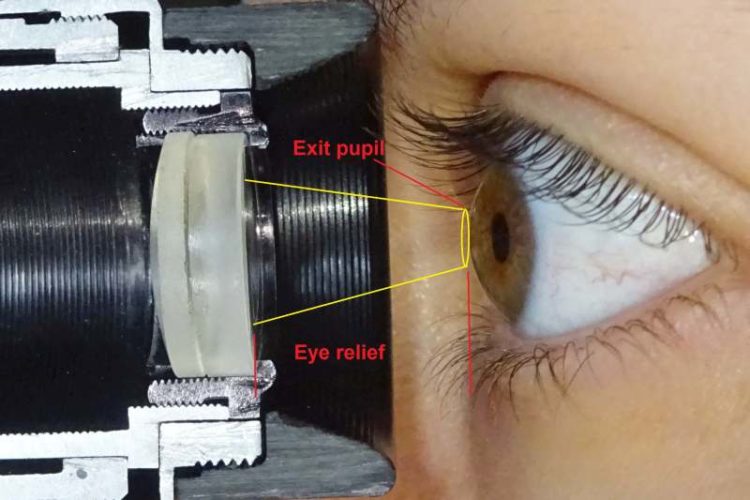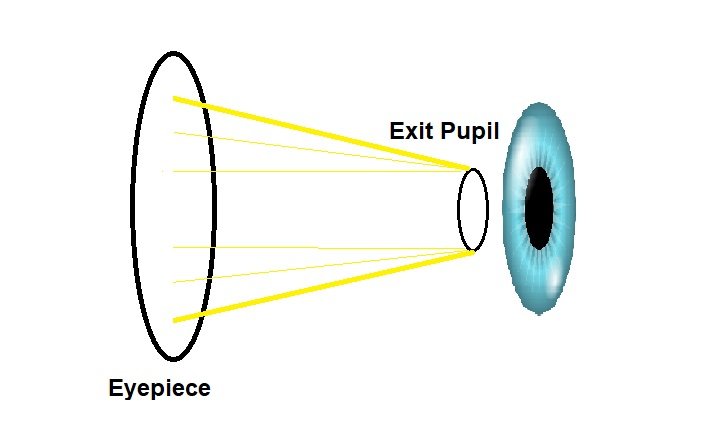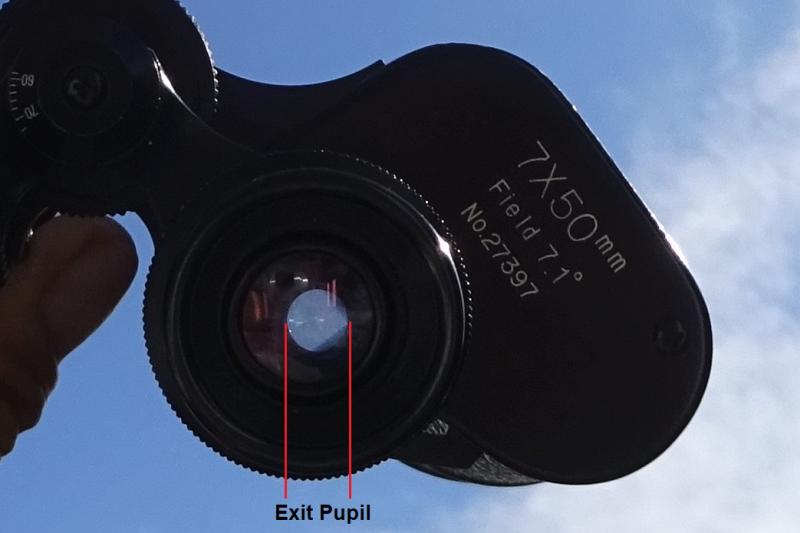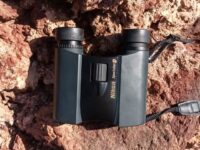The exit pupil of binoculars or telescopes is the diameter of the image that is projected in front of the eyepiece. The larger the exit pupil in binoculars, the brighter the displayed image appears and the better the binoculars are in low light .
The distance where the exit pupil appears is called eye relief. If the exit pupil lies exactly on the pupil of the observer’s eye, then the projected image can be perceived in its entirety.

You can see the exit pupil if you aim your binoculars or telescope at a bright background. Looking at the eyepiece from a distance, you will see the exit pupil as a round disc of light.
The size of the exit pupil, ie the diameter of the light beam emerging at the eyepiece, is directly related to the optical specifications of the instrument. It can be calculated by dividing the objective lens diameter by the magnification.
Exit pupil (EP) = Diameter of Objective lens / Magnification of instrument
EP = DObjective / M
Example as with the 7×50 binoculars from the above image:
- 50mm/7 = 5mm
- Binoculars with the specifications 7 × 50 have an objective lens diameter of 50mm and a magnification power of 7 times. Applying the above formula, the exit pupil is 7 mm (rounded)
This is a fairly large exit pupil that makes sense in binoculars intended for use in low light conditions such as dusk or dawn.
We note that, the larger the objective gets, the larger the exit pupil gets too. And the larger the magnification is, the smaller the exit pupil will be. In all cases, there are trade-offs because of the laws of optics and the limits of the human eye.

The size of the exit pupil can also be determined quite easily in practice. Simply attach a piece of thin paper in front of an eyepiece and then aim the binoculars at a bright background. (Remember do place the paper in the distance of eye relief given). In the eyepiece appears a small round disc of light. The diameter of the projected light spot is then the size of the exit pupil.
What is the ideal Size Exit Pupil
The best size exit pupil depends on the light conditions in which you want to use the binoculars. In bright daylight 4mm is plenty, in twilight or night, you want 5 or more.
In general, you can say that with an exit pupil of around 4 mm you are well suited for general all-round binoculars. The coating of the lenses and thus the transmission is also a factor for low light suitability.
The human eye adapts to the ambient light conditions by opening or closing the pupil. In young people, lots of light as on bright sunny days may have the pupil shrink to 2mm or less, while in low light conditions or at night, the pupil dilates to 8 mm or so.
But as so many things change with age, so diminishes the pupil adaptation. In the elderly, it can be as low as 2 to 4 mm. If your pupil can only dilate to a maximum of 5 mm and you use an 8×56 binoculars (EP 7mm) during dawn in low light, the image will not appear brighter than using an 8×42 instrument (EP 5mm).
Those are the reason why Low Light Binoculars with 8 × 56 or 10 × 56 ratings can be unsuitable for seniors. For a very young observer whose pupils are still more adaptive, the image will appear much brighter though.

The exit pupil of binoculars should be within the range of maximum dilated pupillary diameter so the image appears brightest. In order to be able to determine the ideal size exit pupil and thus buying the right kind of binoculars, you have to consider your age or what’s even better you know how far your pupils can expand.
The Pupil Changes With Age
The pupils of adolescents and young adults open to a maximum of about 7 – 8 mm in low light or darkness. The pupils of seniors dilate to about 3 -5 mm. From the 40th to the 50th year of life one can expect to lose about 1 mm pupil diameter per life decade. Therefore, there is an individual age-dependent maximum ideal exit pupil depending on the age of the binocular user.

Recap – What is the Exit Pupil?
The exit pupil of binoculars and telescopes is the diameter of the light beam leaving the eyepiece.
The value is the quotient of the Objective lens diameter divided by the Magnification:
EP = DObjective / M
The higher the magnification of the instrument in relation to the abjective (ie. Aperture), the smaller the exit pupil at the eyepiece.
For daylight observations an exit pupil of 2 – 4 mm is sufficient. For use in low light conditions and twilight, binoculars with 5 – 7 mm should be chosen.
.
Sources:
imaging.nikon.com/lineup/sportoptics/how_to/guide/binoculars/basic/basic_05.htm
garyseronik.com/understanding-binocular-exit-pupils/
rp-photonics.com/entrance_and_exit_pupil.html

